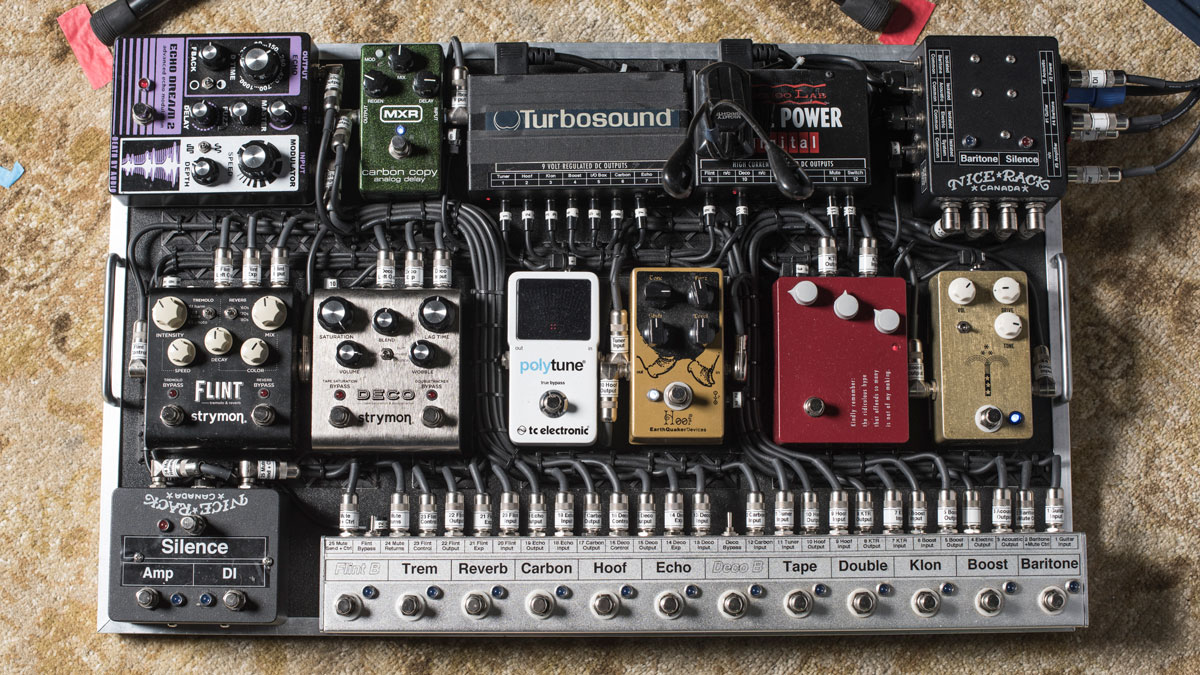
In country music, effects aren’t thought of as the focal point of the tone.
If 90% of it comes from the playing, then 4% is from the guitar, 4% is from the amp, and the last 2% comes from the pedals. Pedals generally serve 3 purposes for country players:
1. Versatility. Most people don’t own every guitar and every amp listed in part 1: guitars and part 2: amps, and even if they do, they can’t bring all of them to a gig or session. Pedals like overdrives, compressors, and EQs can be used to approximate sounds that your amp alone can’t cover.
2. Self-automation. Stepping on a boost pedal for a solo, a distortion for the chorus, and an EQ pedal for the verse gives the part dynamics and development in real time. Every member of a band taking steps like these for different parts of the song is part of the reason Nashville session recordings sound like they’re already mixed as they’re being recorded.
3. Space. A guitar amp can give you a good basic tone, and sometimes reverb, but being able to turn on delay sounds, reverb sounds, and swirly modulation effects all give the guitar a sense of space that helps it sit in a mix and sound professional. Bone-dry guitar sounds that you get from going straight into the amp have some uses, but a large majority of the time, at least one time-based pedal is on to give an added depth to the guitar tone.
And with that in mind, country pedalboards are usually set up in 3 sections:
1. Gain-based pedals
2. Modulation pedals
3. Delays and reverbs
Want all the hottest music and gear news, reviews, deals, features and more, direct to your inbox? Sign up here.
1. Gain-based pedals
Gain-based pedals are used to get different levels of volume, overdrive, dynamics, and frequency balance. It’s good to have at least two of these: one to give you an overdriven rhythm sound, and one to use as a clean boost for lead. More can be added for more versatility, and session players usually have 5-7 of these on their big boards, but 2-3 is the sweet spot for most gigs.
Gain pedals I’ve seen on session players’ boards can be put into the following categories:
Compressors even out the dynamics of your playing without adding overdrive. This is a big part of the Brent Mason-style chicken-pickin' sound. The two most popular are the Keeley Compressor and the Wampler Ego Compressor.
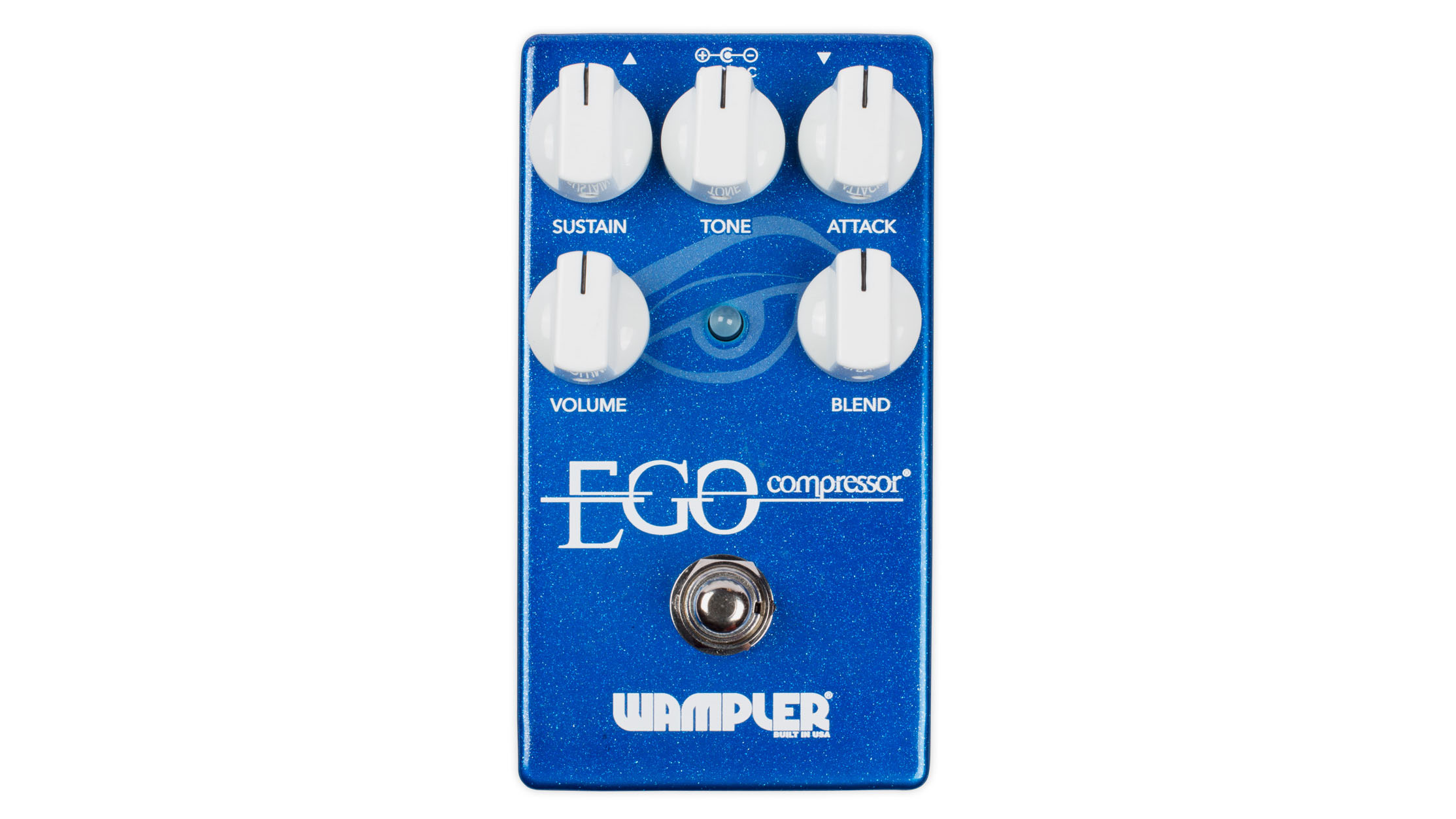
Clean boosts are pedals that add volume and sometimes a small amount of gain to make the amp come alive, and are great tools for making a fill or solo pop out. The Xotic RC Booster is the #1 choice for this, and can be found on most session players’ pedalboards. It’s the most popular individual pedal in the studio.
Transparent overdrives are pedals that add some distortion, but have a relatively flat frequency response and let the amp sound like the amp. This is the most popular category of gain pedal in country music, and there are a lot of different brands and models that make top quality transparent overdrive. Popular choices among session players include the Timmy by Paul Cochrane and the King Of Tone/Prince Of Tone by Analogman.
British crunch boxes are distortion pedals that emulate the overdrive that Marshall amps produce. Usually session players will have a Fender or Vox style amp, and if they need to get into Marshall territory they’ll use a crunch box to get there. The Zvex Box Of Rock and Fulltone OCD are tried-and-true British crunch boxes.
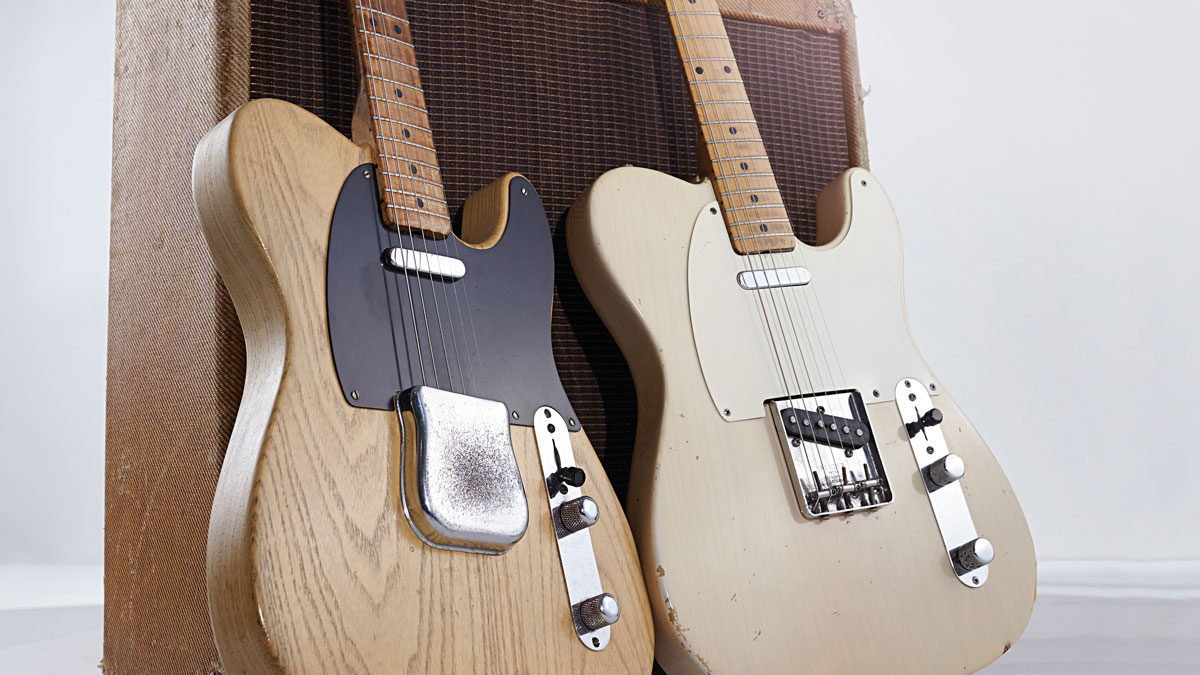
Essential gear for country guitar - part 1: electric guitars
Dumble pedals are pedals that mimic the overdrive of Dumble amps. Dumble amps are legendary, rare, and expensive amps made by Alexander Dumble. They’ve been used by respected guitarists and have a mythology attached to them that has caused pedal builders to try to put their sound into a stompbox. The Hermida Audio Zendrive and J Rockett The Dude are the go-to Dumble pedals.
Klon is a style of pedal that originated with the Klon Centaur. It overdrives like a transparent boost (sounds like an amp) but has a distinctive upper midrange that makes it special. Like Dumple Amps, original Klon pedals are rare and expensive, so some players use original Klon Centaur, some use the reissue Klon KTR, and some use the J Rockett Archer.
Tube Screamers are one of the most classic styles of overdrive pedal. It’s known for having a big mid boost that can help your solos poke through a mix. The Keeley Mod Tube Screamer and Analogman Modded Tube Screamer have been top choices, and Brent Mason’s signature Wampler Hot Wired pedal has a modded Tube Screamer channel on the right side. Nowadays Tube Screamers have been mostly phased out in favour of other types of overdrive, but many of our favourite recordings have Tube Screamers all over them, and that might be the sound you like best!
Fuzz pedals are high-gain distortion pedals that can flub out in a cool way when they’re hit with enough low-end. This is a niche sound and not applicable to chicken-pickin’, but many session players have these on their board for when the moment is right. The Basic Audio Scarab is considered by some to be the best fuzz pedal for recording, and the Way Huge Swollen Pickle is often used for EHX Big Muff-style sounds.
EQ pedals let you literally sculpt the sound yourself, using sliders at different frequency bands to boost or cut different frequencies. The Boss GE-7 is the EQ pedal used upwards of 95% of the time, though it’s usually been modded by Xact Tone Solutions, Analogman or JHS because the stock units tend to be a little noisy.
Wah pedals aren’t overly common in country music, and in practice are thought of more like a modulation effect than a gain effect, but some session players keep a wah on their board, usually some kind of Dunlop Cry Baby. Teese Real McCoy Wahs are also used.
There are also some specific discontinued pedals that have had a resurgance lately, such as the Nobels ODR-1 and Ibanez Mostortion.
2. Modulation pedals
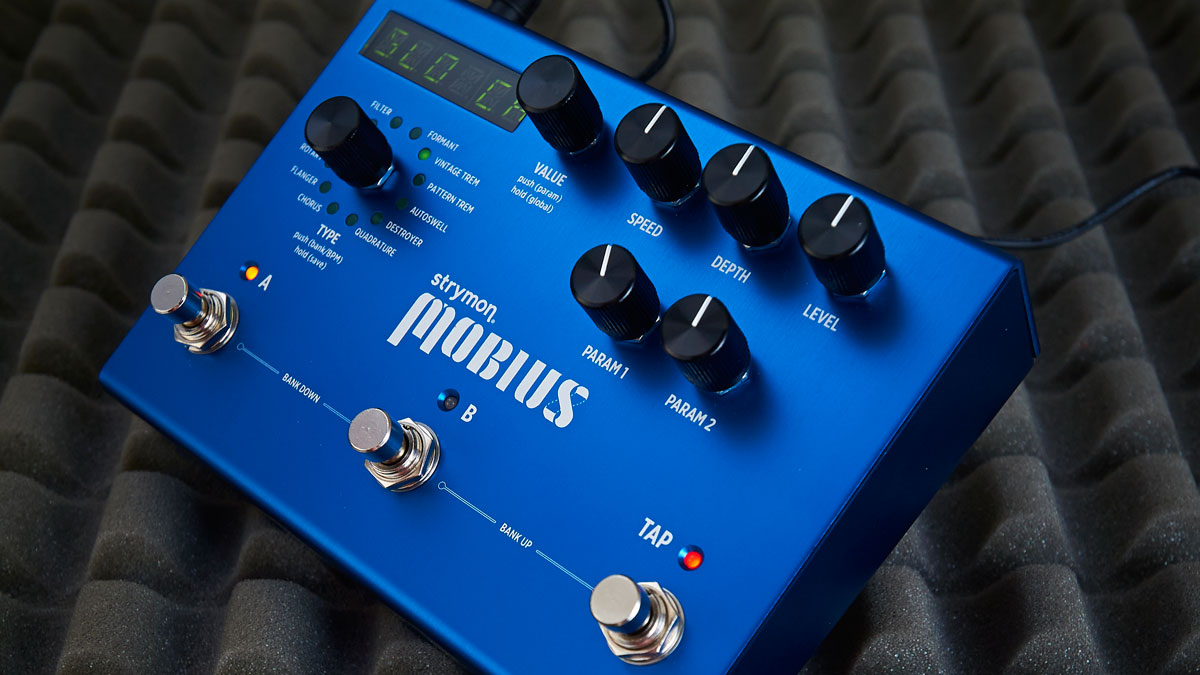
Modulation pedals are used for tones that sound effected. Modulation effects include chorus, phaser, flanger, rotary, tremolo, and vibrato. Due to a bunch of nerdy, specific math stuff these effects are reliably recreated digitally and almost 100% of the time guitarists in Nashville take care of these effects with a digital multi-FX unit. It sounds just as good, saves space, and adds flexibility. Also, tap tempo can be a big deal with some of these effects.
The most popular multi-FX pedals for modulation include the Line 6 M9 (with or without JHV3 mod), Strymon Mobius, and Eventide H9. Strymon also makes slightly smaller, more targeted digital effects pedals that occasionally end up on a 'board.
The only modulation effects that are common outside of a multi-FX are the EHX POG 2 or other POG variant, and the Keeley Mod Boss TR-2, which is a tremolo usually set to mimic an old amp’s tremolo and isn’t tap tempo. The Strymon Flint is a reverb+tremolo pedal that’s designed to sound like the reverb and tremolo circuits of vintage Fender amps and is also commonly used.
If you have a small 'board or fly rig, modulation pedals are the first thing you’d leave off to save space unless you’re playing for an artist that has an obvious modulation effect in the signature lick of one of their biggest songs.
3. Delays and reverbs

Delays and reverbs are also effects that are reliably recreated digitally, but unlike modulation effects, delays and reverbs are completely mandatory. If I was allowed one pedal on a gig, I’d bring a delay pedal. In most country style,s your tone is incomplete and unflattering without a little delay and reverb to give it space.
Delay pedals are everywhere, and it can be hard to figure out the differences between them. To generalise, there are three main types of delay sounds:
1. Tape delay: the original type of delay where the repeats warble and degrade
2. Analogue delay: where the repeats degrade, but don’t warble
3. Digital delay: where the repeats are pristine, though the digital delays most people prefer are from the '80s, where the repeats deteriorate and get blurry.
Most guitarists agree that the repeats of a delay should sound separate and fall behind the original signal, which is why the sound of tape warble, analogue degradation, or low-bit deterioration are preferred sounds, even though we have the capability to make 'perfect' copies of the original signal.
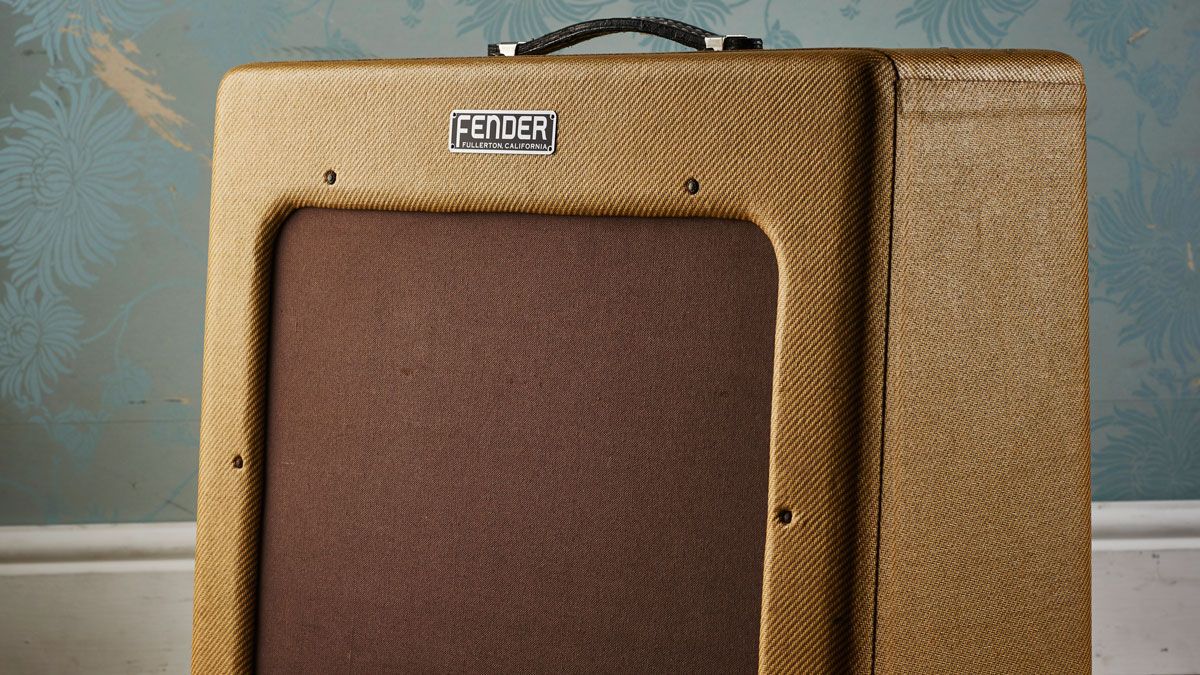
Tape, analog, and old digital delays are modeled reliably on multi-FX units like the Strymon TimeLine, Line 6 M9, and Eventide H9. Strymon also makes smaller, more targeted pedals like the El Capistan specifically for tape delay and the Brigadier specifically for analog delay. The TC Electronic Flashback (and Flashback Mini) offers good digitally modelled delay sounds in a smaller box.
Delay is important enough that many players keep two on their 'board, and sometimes even more. Digital is the way to go for tap-tempo delays, but for non-timed delays like slapback or a one-size-fits-all medium delay, some players will take their old delay stompboxes out and put them back on the 'board.
The Boss DD- series (DD-2 through DD-7) are a common choice; some players prefer something from the EHX Memory Man line of pedals; and popular slap echo pedals include the Way Huge Aqua Puss and MXR Carbon Copy.
Reverb was one of the first effects that guitar players had access to, since it was built into early guitar amps. It has become the norm to have reverb on a guitar sound, to the point that it sounds strange to hear a guitar without at least a tiny little bit of reverb on it.
Guitarists with vintage amps might choose to use the built-in reverb, but most of the time players will opt for a digital reverb pedal to have better control of the sound.
There are different types of reverb, like Hall, Room, Plate, and Spring, and Spring is the one most guitar players go with. It’s the kind of reverb in old amps, so it’s what we’re used to hearing and its inconsistent warbles lend themselves to adding body to an electric guitar sound.
For crazier effects, some players will use Shimmer reverb, which adds upper and/or lower octaves to the reverb for a sound somewhat reminiscent of an organ in a giant church. This is cool at first but gets annoying fast, so it should be treated almost like a modulation effect and used sparingly.
Digital multi-FX pedals with all of the reverb choices you could ever want include the Strymon Mobius, Line 6 M9, and Eventide H9. A lot of guitarists don’t need all the reverbs in the world, and just need a good spring reverb sound, so the Strymon Flint is just as popular as the big multi-FX units for this purpose (plus, it has amp-style tremolo). The TC Hall Of Fame Reverb and TC HOF Mini are also good ways to get reverb on your board in smaller boxes.
Utility pedals, power and cabling
It’s worth mentioning that there are also utility pedals that fall outside of the three categories but are good to have as part of a guitar rig.
Tuner pedals are mandatory. You have to have one. It doesn’t matter which one as long as it works. Popular picks include the Sonic Research Turbo Tuner, Boss TU-2 and TU-3, TC PolyTune, and Peterson Strobostomp.
Power supplies are also mandatory, because you need to power your pedals. The Truetone 1-Spot CS-6, CS-7, and CS-12 are top choices, and some guitarists still use a Voodoo Lab Pedal Power 2 Plus.
Volume pedals could go in the gain section of this article, but they function a little differently. Not every 'board has them, but it’s really useful for volume swells. Ernie Ball and Dunlop are most popular, and some players like active pedals from smaller companies like Hilton or Goodrich.
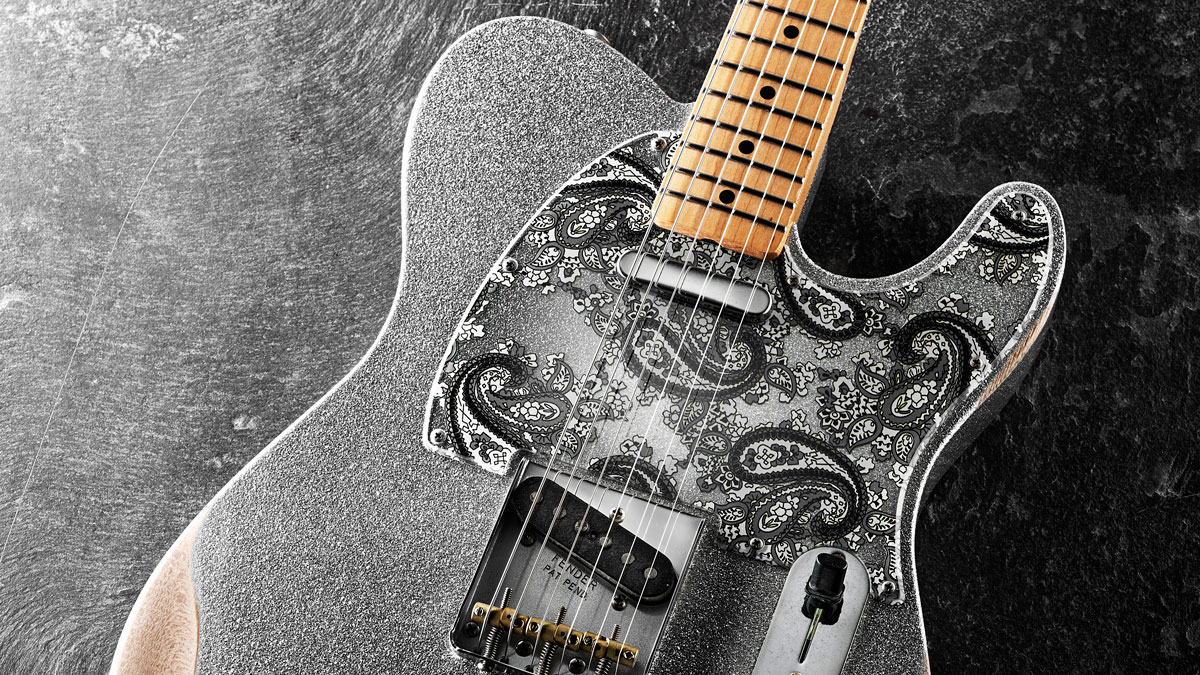
Buffers strengthen your signal so your tone doesn’t degrade over long cable runs. You only need one of these, and you need it at the start of your signal chain. Some pedals are buffered, but true bypass is the norm now, so if you’re running through a bunch of true bypass pedals and it sounds different than when you plug straight into the amp, a buffer will help.
True bypass loop switchers can be helpful if you have a big setup, and Loop-Master is the king of this area. The quality and prices are great, but he has a long waiting list. For live applications, electronic loop switchers can be useful for their flexible routing, and RJM makes some really creative products for this purpose.
Pedalboard cables are a necessary evil that can rack up a big cost when you have a bunch of pedals, and the number of cables doubles when you throw a loop-switcher in there, so most people here use George L’s solderless cables for pedalboards (not from guitar to pedalboard or pedaboard to amp, just from pedal to pedal). They’re easy to assemble and you can get really precise with the lengths. Another benefit is the small size of the connectors and cabling, so it doesn’t get in the way.
Pedalboards are another piece of gear we might not think about because it isn’t super-fun, but it has to be there. Anything from Pedaltrain is great, and 90% of working guitarists in Nashville use a Pedaltrain board of some kind. Session players often have 'boards custom made by Xact Tone Solutions or Trailer Trash Custom Pedalboards.
Country rigs
We’ve covered a lot of ground, and I’ve mentioned about 100 individual products’ names in this series so far, all of which are used by Nashville session players for the purposes of country guitar tone.
How do you take all of this information and distill it down into practical, usable information? It all depends on your tastes, your gig, and your budget. But to give you some benchmarks, I’ll give my top picks for three sizes of rigs.
Note: based on American prices and availability of brand new gear in April 2018
1. Small Rig, under $3000 total
- Fender Classic Player Baja Telecaster - $900
- Fender ’65 Princeton Reverb 1x10 15W Amp - $1000
- Pedaltrain Nano+ pedalboard and soft case- $70
- TC Polytune 2 Mini - $80
- Keeley Tone Workstation - $300
- Timmy - $130
- Strymon Brigadier - $300
- George L’s Cable Kit - $94
- Truetone 1-spot w/daisy chain - $40
Alternatives:
- Vox AC15C1X if you’d rather have a Vox sound
- Line 6 M5 if you’d rather have modulation effects to choose from
- TC Flashback Mini if you wanted a smaller delay and more room for gain/mod pedals
2. Medium Rig, under $5000 total
- Fender Brad Paisley Signature Telecaster - $1200
- Fender ’65 Deluxe Reverb 1x12 22W Amp - $1100
- Pedaltrain Novo24 pedalboard - $170
- TC Polytune 2 Mini - $80
- Keeley Tone Workstation - $300
- Xotic RC Booster - $168
- Timmy -$130
- Zvex Vexter Box Of Rock - $220
- Line 6 M9 - $400
- Strymon Brigadier - $300
- Strymon Flint - $300
- George L’s Cable Kit (x2) - $188
- Truetone 1-Spot CS-12 - $180
Alternatives:
- Vox AC30C2X if you’d rather have a Vox sound
- Analogman Prince Of Tone for transparent drive instead of Timmy
- Fulltone OCD for British Crunch instead of Box Of Rock Strymon Timeline for delay and TC HOF Mini for reverb Eventide H9 with expansion switches instead of Line 6 M9
3. Large Rig, under $15,000 total
- Tom Anderson Hollow T Classic (Tele) - $3200
- Heritage H-150 (Les Paul) - $2600
- Kemper Profiling Amp Powered Rack w/controller - $2700
- Xitone MBritt Cab - $960
- MBritt Profiles ($300 worth) - $300
- SKB 4U iSeries flight case - $500
- Pedaltrain Classic Pro with Tour Case - $350
- Peterson Strobostomp Classic - $200
- JHS Little Black Buffer - $75
- Ernie Ball VP Jr. - $100
- Teese Real McCoy Picture Wah - $235
- Keeley Compressor Plus - $130
- Xotic RC Booster - $168
- Timmy - $130
- J Rockett Archer - $190
- Hermida Audio Zendrive - $240
- Basic Audio Scarab - $200
- Strymon Mobius - $450
- Way Huge Mini Aqua Puss - $150
- Strymon Timeline - $450
- Strymon BigSky - $450
- Strymon Multiswitch - $100
- Strymon Multiswitch - $100
- Strymon Multiswitch - $100
- George L’s Nickel Connectors x12 - $84
- George L’s Nickel Connectors x12 - $84
- George L’s Bulk .155 cable - $110
- Truetone 1-Spot CS-12 - $180
- Loop-Master 12 loop w/tuner out and master bypass (staggered) - $305
- Total: $14,841, woo!
Alternatives: Everything else in this series of articles, with this amount of money you could put together an infinite amount of badass rigs.
If you’re interested in seeing what I actually use, which is somewhat of a hybrid between the Medium and Large rigs right now, go to jimlillmusic.com/gear and subscribe to my youtube videos by going to youtube.com/c/jimlillmusic so you can watch videos about country guitar playing and gear.
If you like my playing and think I know what I’m talking about I have courses on Theory, Brad Paisley, Brent Mason, and more at jimlillmusic.com/full-courses.
Thanks to Zac Childs for vintage guitar and amp lessons, and Station West Studios for giving me a chance to start watching and playing in sessions.